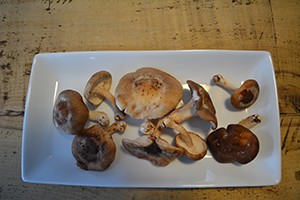Mushroom Farming in Virginia
Mushrooms: A Potential Forest Farming Endeavor

There’s a chance that, if you own a farm in central Virginia, it came with a few (or more than a few) acres of forest land. If you’re a Charlottesville farmer with a woodlot, you should consider the advantages of shiitake mushroom cultivation. It can be a fulfilling (both intrinsically and, of course financially) thing to do with your land and time in the off-season. Shiitake mushrooms are in high demand this time of year. The USDA estimates that they sell for $12-20 per pound (retail). As far as mushrooms go, “shiitake” has a fairly marketable name recognition, but there are many different species of mushroom that could prove profitable: maitake, lion’s mane, and oyster just to name a few.
To begin you would buy mushroom spores marked either sawdust or dowel spawn, referring to the material through which the spores have been run. Shiitake inoculators will generally run you $1-1.50 per log; oyster and lion’s mane inoculators $2, and maitake $3. Spawn comes in “warm season,” “cold season,” and “wide range” variants, referring of course to the climate that best suits the spores. Most people use cold season spawn for the spring and fall and either warm season or wide range for the summer, but new growers should try experimenting as much as they feel inclined.
Growers should only inoculate logs that have been recently cut. It’s recommended that you inoculate at most a few days after cutting. This way you can be sure that your spores are the only fungus contributing to the breakdown of the log. The recommended dimensions are three to eight inches in diameter and between two and four feet long. The logs of oak trees are prime candidates for inoculation, as are many other hardwood trees common to the land in central Virginia. If you’re dealing with maitake, keep in mind that you can actually inoculate the stumps of old trees! Inoculating logs with sawdust spawn is a fairly simple process. After you drill holes in the log, you only need a plunger or similar “inoculation tool.” For dowel, insert dowel spawn plugs into the logs and hammer flush with (or right below) the surface of the log. You want to inoculate by drilling a row of holes into the log and offsetting the holes in the next row. To figure out how many holes to drill, simply subtract the number of inches of the log by 1. This is not a hard and fast rule, just a guide. Then keep the logs incubated until the mushroom has had a chance to fully colonize the log. After this, you want to lay the logs out in the shade (between 75-80% shade) and make sure to keep moisture levels high. To determine how much moisture your batch is getting, it’s useful to have a “moisture log”; that is, a log that is not inoculated but experiences the same conditions as your inoculated logs. Simply cut a piece off, weigh it, and put it in the oven. Then weigh it again.
You must take steps to sterilize the inoculation site. The most common way to do this is to use food-grade wax at about 400 degrees. It’s not always enough to sterilize the inoculation points; one must coat any raw wood sites in wax. That means branch stubs, the ends of the log…anywhere that the interior of the log is exposed. Grab a turkey baster (metal is recommended for the hot wax) and get to work!
If you’re reading this from Charlottesville or one of the surrounding counties, you probably already know that there is a built-in market for fresh, local food. Mushrooms are no exception. The prominence of the farm-to-table movement in Charlottesville means that there are a wealth of restaurants, grocery stores, and farmers’ markets that need local food, and fast. If you’re already a farmer and you’re looking to diversify your crops and keep busy in the off-season, mushroom farming may be for you. This is meant to serve as only an introduction to mushroom farming. There is much more info out there. Check out the USDA’s guide to farming mushrooms for more information.